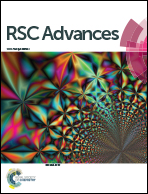A reversible pH-modified fluorescence transition in block copolymer micelles enwrapped with a zinc(ii) fluorescent complex†
Abstract
A reversible pH-modified blue to green luminescent transition system was constructed by encapsulating bis(2-(2-hydroxyphenyl)benzothiazolate) zinc (Zn(BTZ)2) within poly(styrene-b-acrylic acid) (PS-b-PAA) micelles. The system can respond to changes in the external pH environment from alkaline (7.0–10.5) to weakly acidic (4.5–7.0) conditions, which are absent for the pristine Zn(BTZ)2 dimethylformamide solution state, and designated as blue and green micelles, respectively. The tunable pH-modified luminescent behavior probably originates from changes in the Zn(BTZ)2 molecular packing modes modified by the shrink/swell morphology transition of the copolymer micelles due to the reversible ionization of the carboxylic group. The emission transition from blue to green can be further detected through affecting the Zn(BTZ)2 intermolecular interactions upon grinding the Zn(BTZ)2 powder. The micelles were further fabricated to form films by electrostatic layer-by-layer assembly with positively charged layered double hydroxide (LDH) nanosheets, which are responsive to acidic and alkaline atmospheres and show higher UV resistance compared to the micelles/PDDA (poly(dimethyldiallylammonium) chloride) film.


 Please wait while we load your content...
Please wait while we load your content...